With the right approach, Google Search Console (GSC) can be a game-changer for growing your website traffic. It is a robust, free tool developed by Google, designed to help website owners gain insights into how their sites are perceived by the search engine’s algorithm.
While managing our websites, we use GSC to uncover valuable data on our sites’ performance and opportunities to enhance your SEO strategies and attract more visitors. Unfortunately, most businesses miss out on the full capabilities of this tool to boost their organic traffic effectively.
In this article, we will show you how to properly use Google Search Console to improve your website SEO and get more visitors.
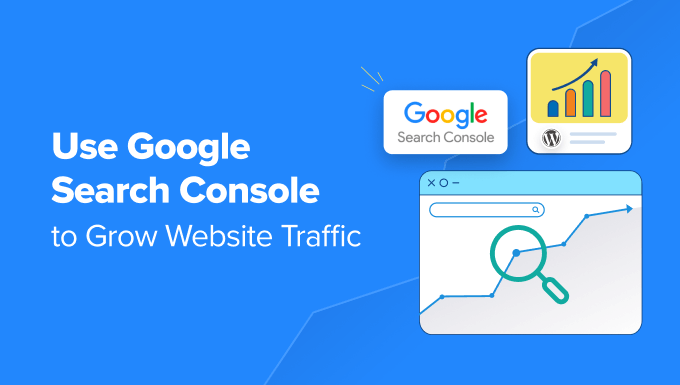
What Is Google Search Console?
Google Search Console is a free tool offered by Google to help website owners monitor and maintain their site’s presence in Google search results.
It provides essential marketing data that you need to start tracking from day one. It also lets you know about errors, security issues, and indexing problems that may affect your website’s search rankings.
You can use all this information in your WordPress SEO strategy to increase your website traffic.
The sad thing is that most businesses don’t utilize the full power of Google Search Console because most of them think that just adding their website to Google Search Console is enough.
There’s so much more that you can do with the tool.
If you are not leveraging all of the powerful features that Google Search Console offers, then you are missing out.
Luckily, we are here to help. We have created this ultimate Google Search Console guide to help you grow your website like a Pro.
Since this is a comprehensive guide, we have added a table of contents for easier navigation:
Setting Up Google Search Console
- Adding an XML sitemap
- Adding your website to Google Search Console
- Connecting Google Search Console to Google Analytics
Fixing Crawling Issues
- Finding and fixing search indexing issues
- Fixing 404 errors in Google Search Console
- Fixing soft 404 errors in Google Search Console
- Fixing server errors in Search Console
- Finding and fixing security issues
- Fixing manual actions and requesting a review
Growing Your Website
- Using Google Search Console to grow traffic
- Mining keyword data in Google Search Console
- Finding low-hanging keywords where you can easily rank
- Using link reports in Google Search Console
- Getting more backlinks from third-party websites
- Improving internal linking to boost rankings
- Using Core Web Vitals in Search Console
- Viewing Google Search Console data inside WordPress
Useful Google Search Console Tools
- Creating rich snippets for your WordPress pages
- Using Google Search Console to improve mobile usability
- Checking the status of a page using the URL Inspection tool
- Removing URLs from Google Search
- Adding users to access Google Search Console
1. Adding Your Website to Google Search Console
If you haven’t already done so, then you need to go ahead and add your website to Google Search Console. It is really simple and will only take a few minutes.
Simply go to the Google Search Console website and click on the ‘Start Now’ button.
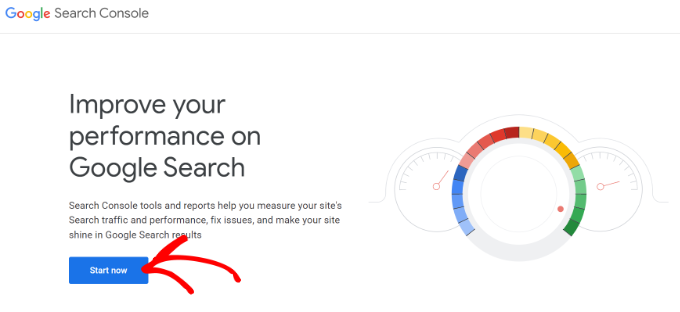
You will be asked to sign in using a Google / Gmail account. Once logged in, you will need to enter your website URL.
Google Search Console offers 2 methods for site verification, including domain name or URL prefix. We recommend using the URL Prefix method as it provides more flexibility.
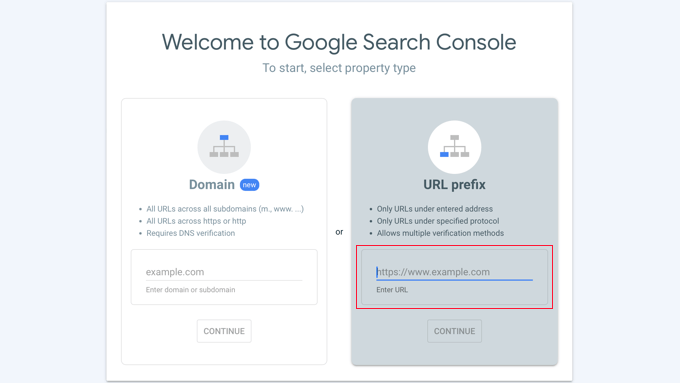
Keep in mind that Google considers HTTP and HTTPS as two different protocols. It also considers https://www.example.com and https://example.com as two different websites.
You will need to make sure that you enter the correct URL for your website.
If you are unsure, then simply log in to your WordPress admin area and go to the Settings » General page. There, you will see your website’s URL in the Site Address field.
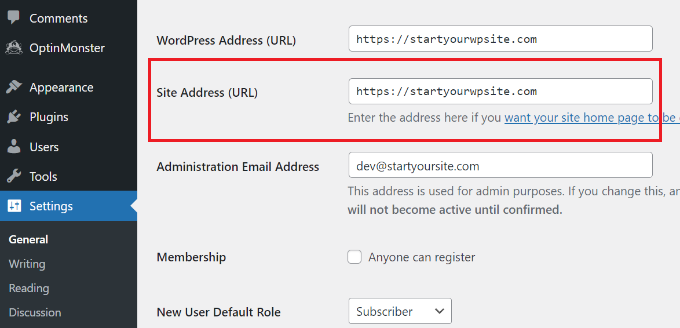
After entering your website address, click on the ‘Continue’ button.
Next, you will be asked to verify ownership of your website. There are several ways to do that, but we will show the HTML tag method because it is the easiest one.
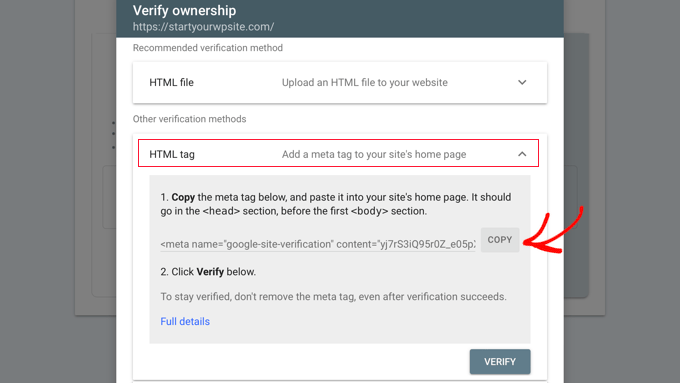
Click on the HTML tag to expand it and then copy the code inside it.
Next, you will need to add the code to your WordPress website so that Google can verify the ownership. However, this requires coding, which can be tricky for beginners.
An easier way of adding Google Search Console to WordPress is by using All in One SEO (AIOSEO). It’s the best SEO tool for WordPress and is used by over 3 million users.
First, you will need to install and activate the AIOSEO Lite plugin. For more details, see our step-by-step guide on how to install a WordPress plugin.
Upon activation, you can go to the AIOSEO » General Settings page and then click the ‘Webmaster Tools’ tab. Next, select the ‘Google Search Console’ option under Webmaster Tools Verification.
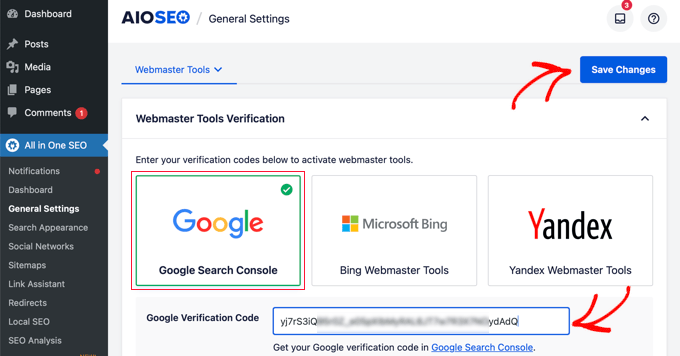
After that, go ahead and enter the code you copied earlier from Google Search Console into the ‘Google Verification Code’ box.
Don’t forget to click on the ‘Save Changes’ button to store your changes.
You can now go back to Google Search Console settings.
You need to click on the ‘Verify’ button.
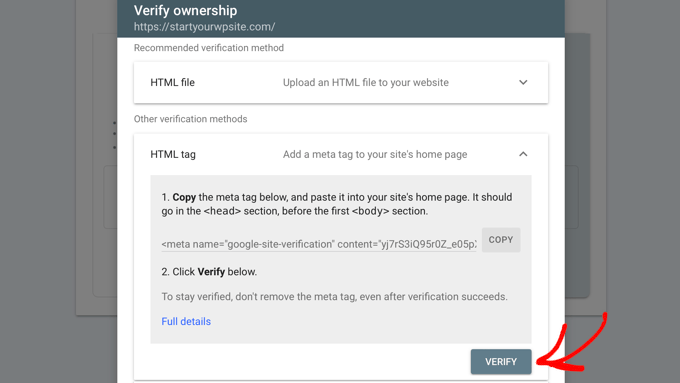
Google Search Console will now look for the HTML tag in your website code.
Then, it will show you a success message.
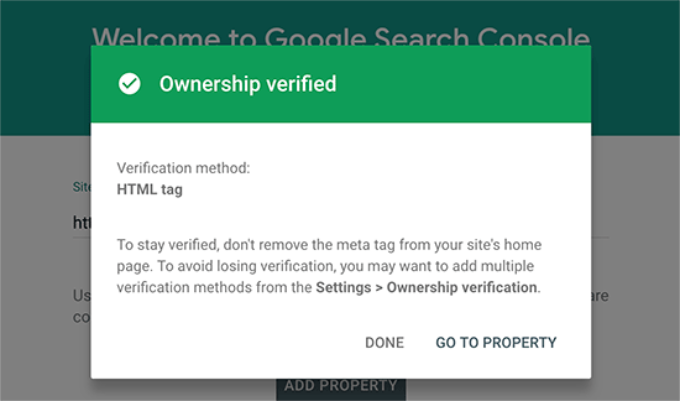
That’s all. You have successfully added your site to Google Search Console. You can now click on the ‘Go to Property’ link to visit your Google Search Console dashboard.
Note: If Google Search Console cannot verify your website after you have added the code, then you need to make sure to clear your WordPress cache and try again.
2. Adding an XML Sitemap
An XML sitemap is a way for website owners to tell search engines about all the pages that exist on their website. It also tells search engines which links on your website are more important than others.
Adding an XML sitemap to your website helps search engines better crawl your content. While it doesn’t give you a boost in search rankings, it can definitely help search engines index your content more efficiently.
Plus, if you installed All in One SEO (AIOSEO) in the first step, then the plugin automatically adds an XML sitemap to your site.
To see the sitemap, you can head over to All in One SEO » Sitemaps and make sure that the toggle for ‘Enable Sitemap’ is switched on.
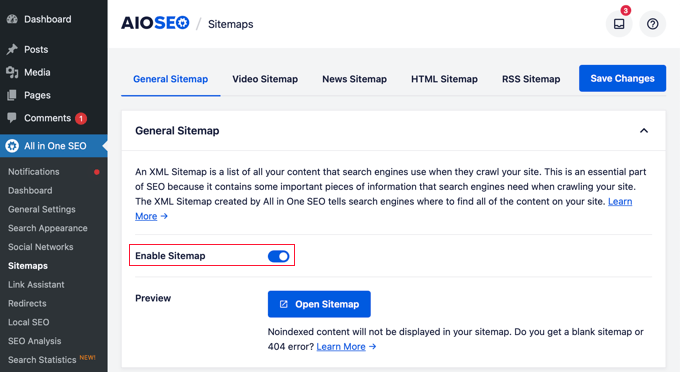
The plugin will automatically generate an XML sitemap for your website, and you can find it at the URL that looks like this:
http://example.com/sitemap_index.xml
Don’t forget to replace example.com with your own domain name. You can now submit this URL in Google Search Console.
Just head over to the Google Search Console dashboard and then click on the ‘Sitemaps’ option from the left column. After that, you can paste the URL and click the ‘Submit’ button.
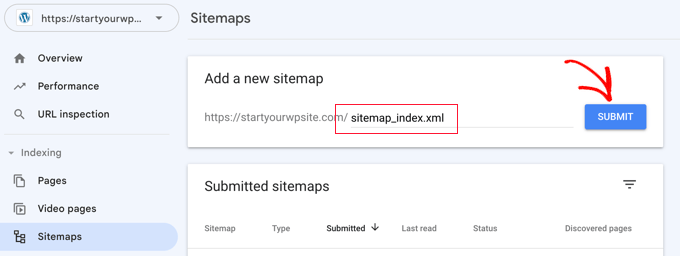
Google Search Console will now check your sitemap and use it to improve your website’s crawling. You can go through our guide on how to add a sitemap page in WordPress for more details.
3. Connecting Google Search Console to Google Analytics
Connecting Google Search Console to your Google Analytics account helps you analyze search console data in Google Analytics. This provides you with a new perspective on your top-performing content and keywords.
If you haven’t already done so, then you will need to install Google Analytics on your WordPress website.
We recommend using MonsterInsights for this. It is the best Google Analytics plugin for WordPress, and it will automatically show your top keywords from Google Search Console in your WordPress admin area.
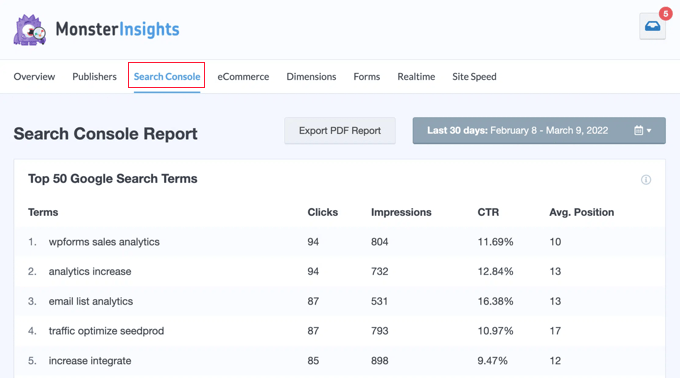
However, if you wish to see the Google Search Console report on the Google Analytics website, then you will first need to connect the two services.
You can connect Google Search Console to your Analytics account from either the Google Search Console or Google Analytics website. For this tutorial, we will initiate the connection from Google Search Console since we are already there, and it’s easier.
In the bottom left corner of the Google Search Console screen, click on the ‘Settings’ button. Then under ‘General settings’ you should click on the > arrow next to ‘Associations’.
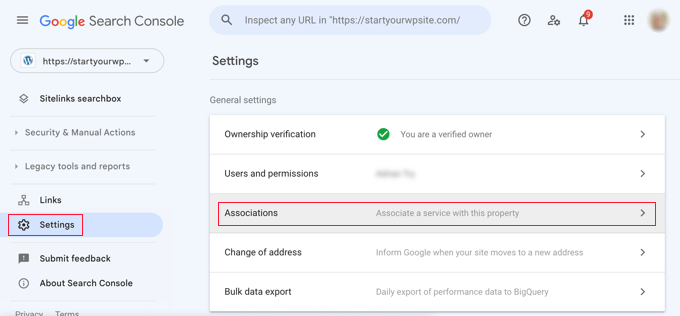
This will open a page where you can see a list of services you previously associated with Google Search Console, if any. However, if you have not already associated with Google Analytics or any other Google service, then the list will be empty.
Under that, you will see a link where you can associate Google Analytics with Google Search Console. Simply click the word ‘Associate’ to get started.
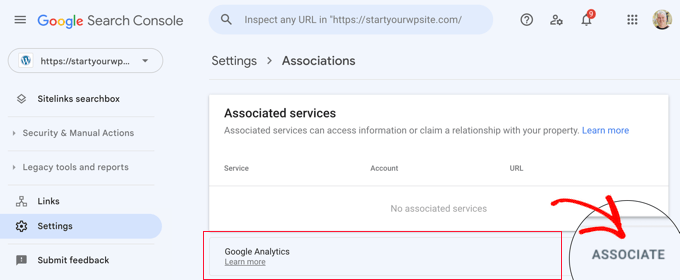
You will see a popup asking you to select the Google Analytics GA4 property you wish to associate. After that, you will see another popup asking you to select the GA4 web stream.
Finally, you will see a third popup asking you to confirm the association. Simply click the ‘Associate’ button to confirm.
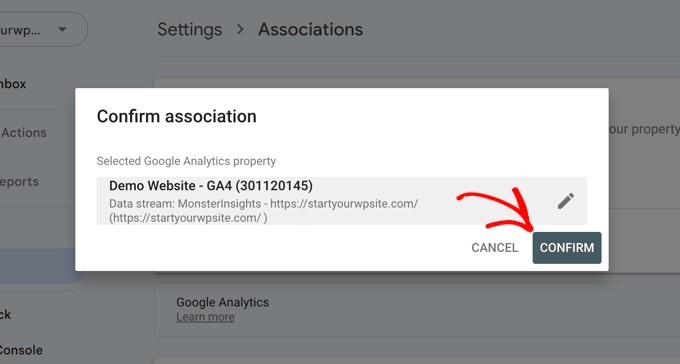
That’s all. You have successfully connected your Google Search Console data to your Analytics account.
You can now see on the Google Analytics Search Console settings page that Google Analytics is an associated service.
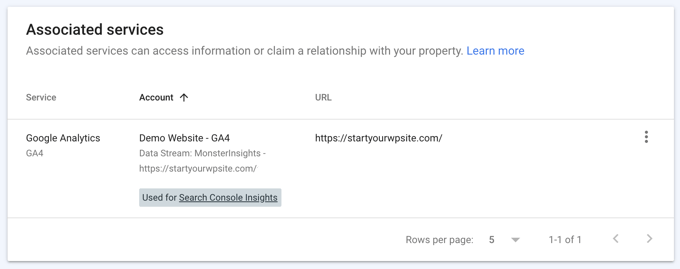
Google Search Console data is available 48 hours after it is collected, and will go on being available for the next 16 months.
Now you can add the Google Search Console report to Google Analytics.
You need to visit the Google Analytics website and make sure you are logged in. Once there, you need to click the second icon at the left of the screen, which is ‘Reports’.
After that, you should click ‘Library’ in the menu on the left of the screen.
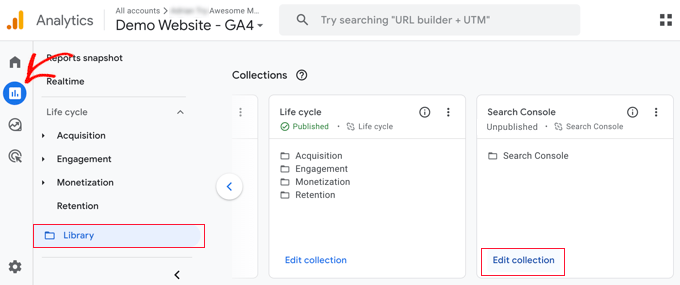
Now, under ‘Collections’, you need to find Search Console and click ‘Edit collection’.
You don’t need to make any changes on the next screen. Simply click the ‘Back’ button at the top of the screen.
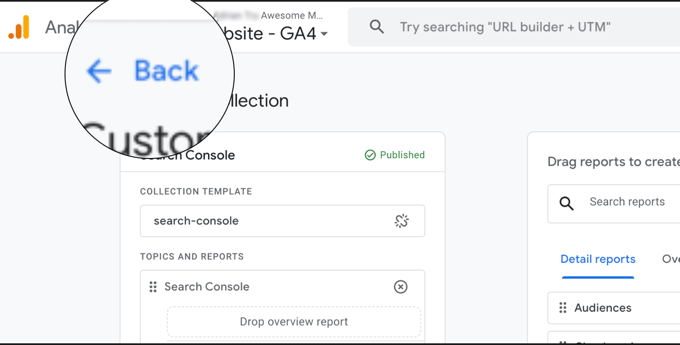
Now, you can click the 3 dots at the top of the Search Console card to show more options.
A drop down menu will appear, and you should click ‘Publish’.
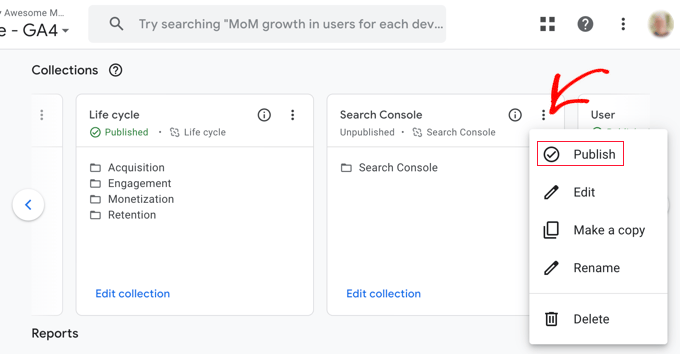
This will add a new Search Console section to the navigation menu for Google Analytics Reports.
Now, you can view your Google Search Console report in Google Analytics by navigating to reports and then expanding the Search Console section.
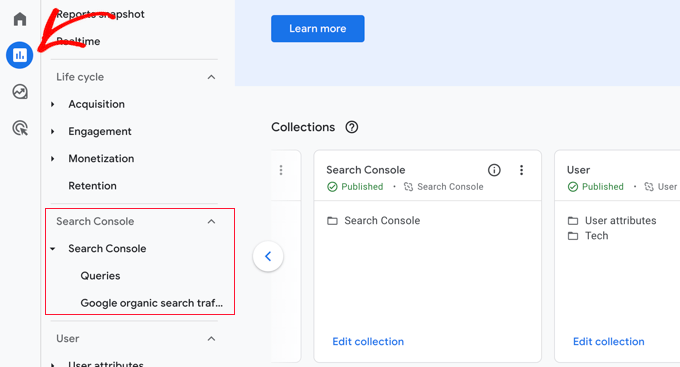
4. Finding and Fixing Search Indexing Issues
The most helpful feature of Google Search Console is that you can troubleshoot indexing errors.
These errors can affect your organic search rankings by stopping search engines from crawling and indexing the pages on your website.
You can easily locate these errors in the Pages report (previously called the Coverage report).
It shows you which pages from your website are indexed by Google and which pages resulted in an error or a warning.
When you scroll down, you will see a detailed list of all the errors. Clicking on a link will open the detailed view, where you will also find the link to learn more about the error and how to fix it.
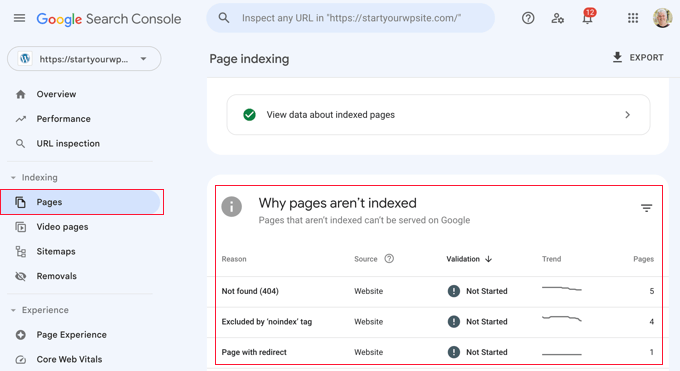
The following are a few common indexing errors you may see:
- 404 error – This error means that the crawler followed a URL and saw a 404 error.
- Soft 404 error – This error occurs when the crawler sees a 404 error page, but the page’s status code sends a 200 (success) message to the browser.
- Server error – This means that your website server timed out or didn’t respond. This could happen if your website was under heavy traffic, under maintenance, or unavailable for any other reason.
- Not followed – This error occurs when Google is not able to follow a content type. This could be a flash, JavaScript, iframe, or other resources that the crawler cannot fetch.
Now, let’s take a look at how to fix some of these crawl errors.
5. Fixing 404 Errors in Google Search Console
First, you need to keep in mind that not all 404 errors are equal. You can safely ignore some of them and only fix those that are actually errors.
For example, if you deleted a blog post and don’t want to redirect users to a newer post, then it is ok to let Google see a 404 error page. Google will eventually deindex that page if it keeps seeing the 404 error.
However, the reason Google wants you to look at those 404 errors is that you may not be aware of them. For example, you accidentally deleted something or forgot to redirect users to the new, updated version.
Simply click on the error in the Pages report, and it will show you all the pages displaying that error. Carefully review the pages, and if you see a page that shouldn’t be there, then copy its URL and open it in a new browser window.
If you see a 404 error page in your browser, then this means that you need to fix this page.
Now, if it is a page that no longer exists, but you have a newer or similar version of it, then you will want to redirect users to that page. See our guide on how to set up redirects in WordPress.
However, sometimes, 404 errors may occur due to a misconfiguration in the WordPress permalink structure.
To fix this, simply visit Settings » Permalinks and then click on the ‘Save Changes’ button without changing anything.
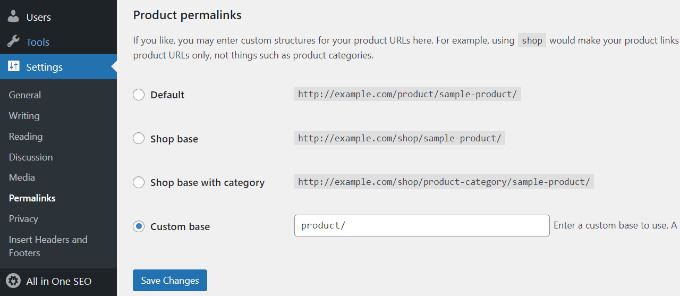
6. Fixing Soft 404 Errors in Google Search Console
Soft 404 errors are a bit tricky to troubleshoot.
Basically, these errors occur when the Google bot sees what looks like a 404 error document instead of content. However, your server is sending a 200 (success) code.
Normally, your server sends a 200 success code when a page is displayed without an error or redirect.
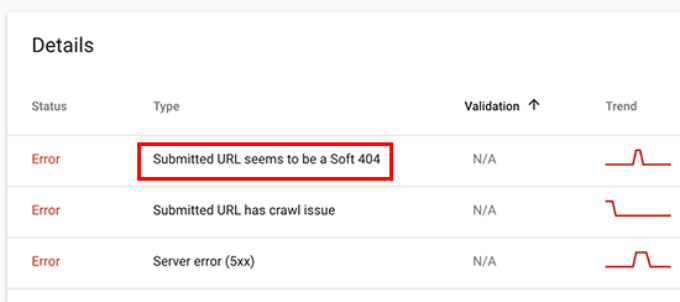
To resolve soft 404 errors, go ahead and click on the errors in the Pages report to view the list of affected pages.
Now, you need to open the page in a new browser tab to see what’s happening. If the page displays correctly, then you can safely ignore the error.
On the other hand, if the page is showing a 404 error document, then you may want to investigate further.
Start by clicking the ‘Submitted URL seems to be a Soft 404’ link from the Pages report. Next, you can open the link in a new tab to check if it’s not a false alarm.
If the page is valid and you want it to appear in the search results, then simply click the ‘VALIDATE FIX’ button. Google will then recrawl the page and change the status error.

If the WordPress search function causes the soft 404 errors you are seeing, then the easiest solution is to stop the Google bot from crawling search URLs.
To do that, you need to add the following lines to your robots.txt file:
User-agent: *
Disallow: /?s=
Disallow: /search/
Usually, Google Bot doesn’t crawl search URLs. However, some spammers might try to spam Google search console reports by linking to search URLs with random strings. This way, they hope you will see their link in your Search Console report and click on it.
If the affected URLs are not searched queries, then you may want to redirect them to a proper page on your site.
7. Fixing Server Error in Google Search Console
Server errors in Google Search Console are caused by a number of reasons. The most common cause is when your server times out during a crawl, throws an unexpected error or does not appear to be online.
You can use the ‘URL inspection’ tool to make sure that the affected URL is working.
If it is working, then you can ignore the error. If you are on a reliable WordPress hosting provider, then most server errors will disappear automatically.
However, if you can confirm the error by visiting the URL, then there are several things you can do to fix it. See our list of the most common WordPress errors guide to find a fix for the specific error message you are seeing.
8. Finding and Fixing Security Issues
Security issues not only stop Google from crawling your website, but they could also cause a sudden drop in search traffic. Google may temporarily remove affected pages, show a warning to users, and drop a page’s ranking.
Security issues will be highlighted on the overview screen when you log in to your Google Search Console account. The most common WordPress security issue is a website affected by malware and trojans.
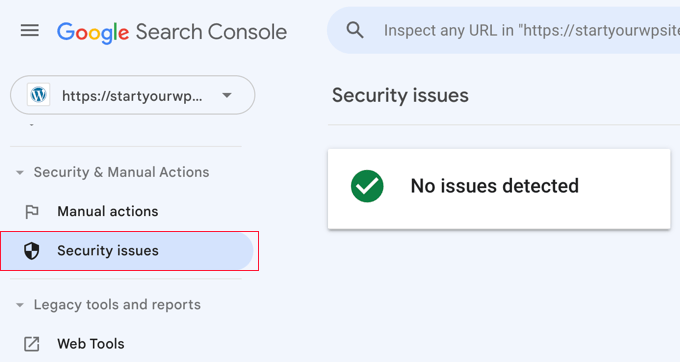
To fix this, see our guide on how to clean a hacked WordPress website for step-by-step instructions.
You can also see our article on how to fix a website after getting de-indexed by Google.
9. Finding Manual Actions and Requesting a Review
While security issues are automatically triggered, manual actions are the penalties that are imposed by human staff from the Google Search team after a careful review. If a manual action is taken against your website, then this is pretty significant and can immediately take away all your search traffic.
These manual actions usually occur when a website is involved in illegal activities, spamming, and other fraudulent or fishy activities.
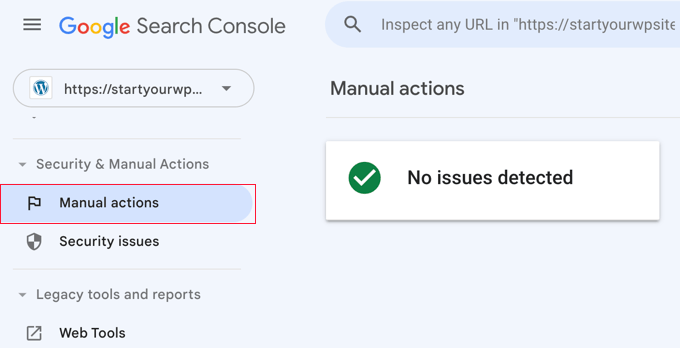
Clicking on the ‘Manual Actions’ link will show you the actions in your search console report. You will also find detailed information about the issue that triggered it and how to clean it up.
Once you have removed the objectionable content, you can click on the ‘Request review’ button. Your website will now be reviewed and reconsidered by the Google Search team, and they can decide to remove the penalty.
10. Using Google Search Console to Grow Traffic
Now that we have covered the technical bits, let’s get to the fun part of growing your website traffic by using the data available in Search Console.
Google Search Console helps you uncover keyword data, find out your top-performing keywords, and discover hundreds of potential keywords where you can easily rank and get more traffic.
We will also look at links and how to use them to improve search performance.
Ready? Let’s get started.
11. Mining Keyword Data in Google Search Console
Keywords are the search terms users type in search engines to find information.
Marketers and website owners can optimize their content to target desired keywords and improve their chances of appearing on top in search results.
You can also view the keyword data in your Google Search Console reports.
It gives you a full view of the keywords your website is ranking for, average position, clicks, and impressions (number of times your site appears for that keyword).
You can see this information in your Google Search Console reports under the ‘Performance’ tab.
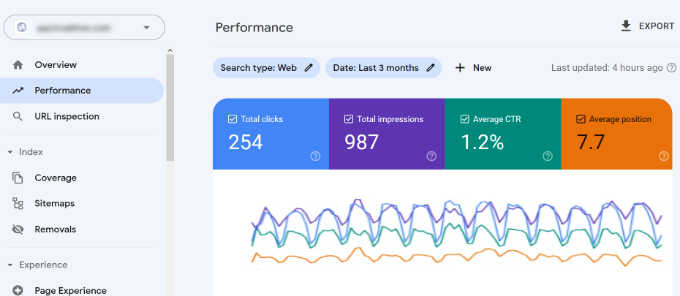
On the top, you will see a graph of your website’s performance on search engine results pages (SERPs).
Below that, you will see the keyword data, which you can filter by position, impression, and click-through rate.
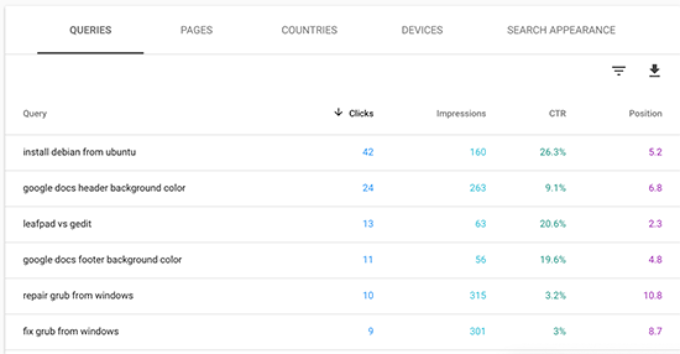
You can sort this data by clicking on any column.
You can also use the filter option to narrow down the results.
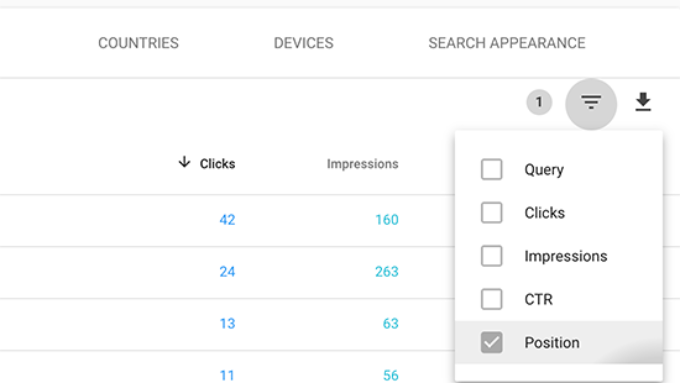
Just switch to the ‘Pages’ tab to see the performance of your pages in search results.
Clicking on any page in the list will filter the results for that page. You can then switch to the ‘Queries’ tab to see the keywords that bring the traffic to that particular page.
Now that we have covered how to browse and view this data, let’s see how to actually use this in your SEO and content planning.
12. Finding Low-Hanging Keywords Where You Can Easily Rank
A lot of your pages may be ranking on page 2 or 3 of Google search results for different keywords. These are the keywords that you can quickly work on to rank higher and get more traffic.
Let’s find those keywords.
In your Performance report, click on the filter icon and then select the ‘Position’ option. Next, you will be looking for keywords where the average position is higher than 7.
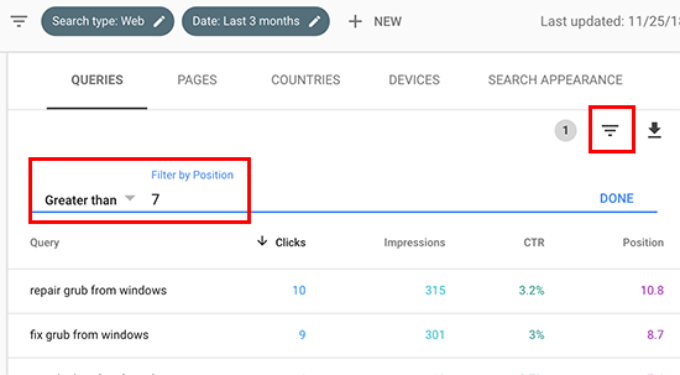
Search Console will now only show the keywords where your site appears on an average position of 7 or higher.
Now, click twice on the ‘Position’ column to sort the list in ascending order.
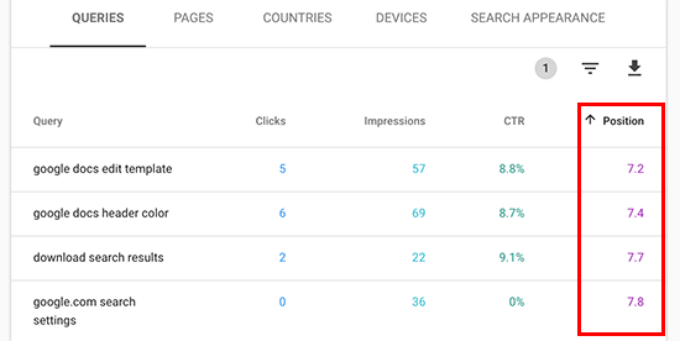
As you scroll down, you will find tons of keywords that rank between 7 and 30. All these keywords are low-hanging fruits where you can easily rank higher.
To view more results, scroll to the bottom and select a higher number for ‘Rows per page.’

When choosing the keywords to work on, you will want to pick them based on the number of impressions. Higher impressions mean more search traffic for those keywords.
To do that, you can export the data in CSV format and then open it in spreadsheet software.
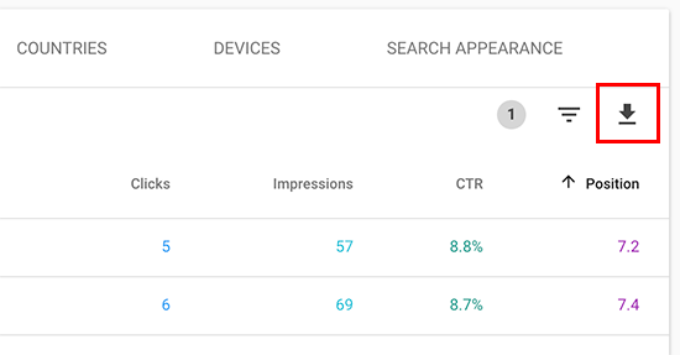
Now that you have mined the low-hanging keywords with higher impressions, the question is, how do you improve your rankings for those keywords?
Here are some tips to help you improve your rankings for those keywords.
1. Improve the Content by Adding More Useful Information
The #1 reason your page isn’t ranking for a keyword is that Google finds other content more valuable. To counter that, you need to review your article or blog post and add helpful content.
Look at the articles ranking in the top 5 positions for that keyword and cover all the information that your article is missing in more detail.
We are not saying that you should just add more text to it. You need to make it more useful, informative, and comprehensive.
For more details, you can see our guide on how to write a great blog post.
2. Evaluate On-Page SEO
Using All in One SEO (AIOSEO) can improve the on-page SEO (search engine optimization) score for your article. It gives practical tips on improving a page by analyzing the content, keyword density, title, readability, links, and more.
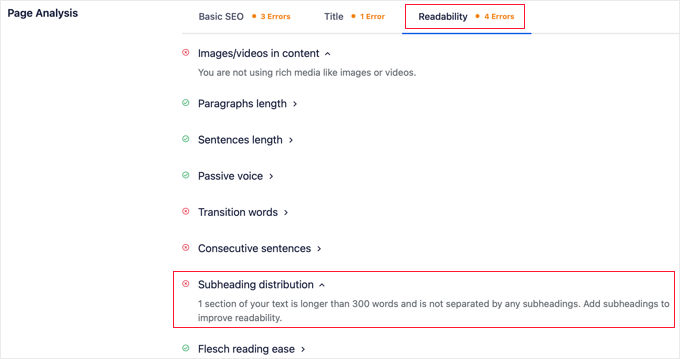
You can also check out our SEO audit checklist to boost your rankings.
3. Increase the Time Users Spend on That Page
Google considers it a success when users click on a search result and spend time viewing it. This means your content needs to be highly engaging and instantly provide users with the information they are looking for.
Here are some crazy simple things you can do to increase user engagement:
- Use images – Users find images much easier to look at than text. Adding more images makes it easier for users to scan the information and keeps them engaged.
- Use videos – Videos are the most engaging form of content available. Adding video to a page significantly increases the time users spend viewing that page.
- Make text more readable – Use smaller paragraphs, lots of white space, simpler sentences, and keep your style casual and conversational. All these things make reading easier for users.
For more tips, see this article on how to increase the time users spend on your site.
13. Using Link Reports in Google Search Console
Links play an important role in WordPress SEO. Search engines use them as a metric to determine how important a page is and where it should rank in search results.
The Links report in Google Search helps you see your website’s performance in terms of links.
It shows you external links, internal links, top-linking sites, and top-linking text. More importantly, it shows top linking sites, how often they link to your site, and how many pages they link to.
Let’s see how you can use these reports to get more backlinks, improve internal links, and boost your rankings.
14. Getting More Backlinks From Third-Party Websites
Google Search Console shows third-party websites that have linked to your site in the ‘Top linking sites’ report.
You can expand the report by clicking on the ‘More’ link at the bottom.
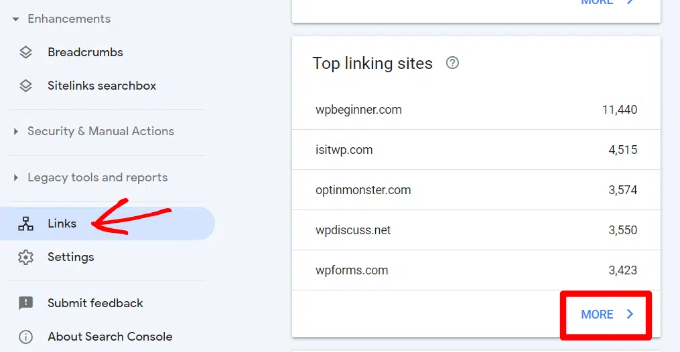
If you click on a domain name to expand the report, you will see all the pages they have linked to. Next, click on each page to get the exact URL linked to that particular page.
You can now use this data to get more backlinks for your site. Simply visit the website and see how they have linked to you. After that, see what other content they have where your site can be linked from.
Next, simply reach out to the website via email or the contact form on their website.
First, thank them for linking to your article and then politely mention that they may want to include a link to an article of yours.
Now, this direct approach may not always work. In that case, you need to be creative. You can offer them to write a guest post for their blog, leave comments on their articles, follow them on social media, or retweet their articles.
Repeat the process for all important external links on your website. With consistent effort, you can get proper backlinks without spending any money.
15. Improving Internal Links to Boost Rankings
It is harder to get third-party websites to link to your content. However, it is way easier to link to your own content from your own site. This practice is called internal linking.
Internal linking helps search engines understand the context and relationships among different pages on your website. It also helps them understand which pages are important based on how often you have linked to them.
This is why you should make internal linking a habit when writing new content on your website or blog.
Now, let’s see how to use the links reports in Search Console to help you build internal links.
In Google Search Console, click on the Links report and then click on the ‘More’ link in the ‘Internal Links’ column. The report shows how often you have linked to other pages on your site.
Go ahead and click the filter icon and then select the ‘Target page’ option.
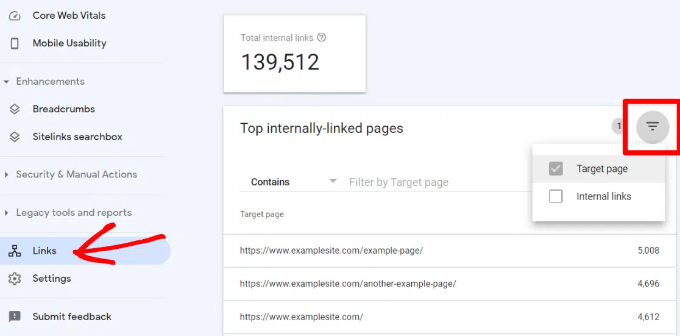
Search Console will now show you how many pages are linking to this page. You can now compare it with other pages and see whether pages with more internal links are ranking higher than posts with many internal links.
If that’s the case, then go ahead and start adding internal links to pages that you want to rank higher. Make sure you are only linking to the article when it makes sense. Adding links where they don’t make sense would create a bad user experience.
Related: To make internal linking even easier, you can check out our picks of the best internal linking plugins for WordPress.
16. Using Core Web Vitals in Search Console
Did you know that Google considers your website loading speed as a ranking factor?
In 2020, Google introduced Core Web Vitals, which measure how fast your website is and helps the search engine measure your site’s user experience.
In Google Search Console, you can view the ‘Core Web Vitals’ report under the Experience menu on your left. It provides a complete report about your site’s speed score for mobile and desktop.
The best part is that you also get recommendations on how to improve your Core Web Vitals scores and improve your site’s load time.
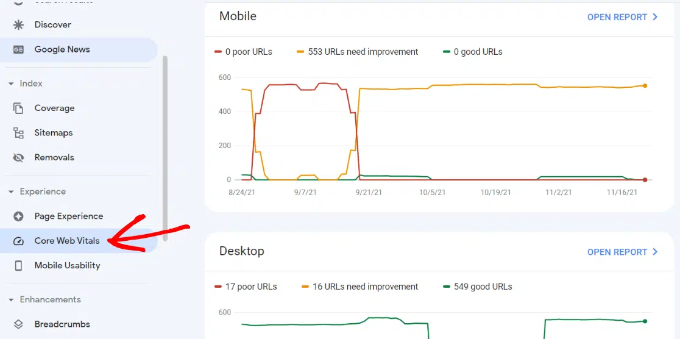
For more information, please refer to our guide on how to boost WordPress speed and performance.
Viewing Google Search Console Data Inside WordPress (Bonus Tip)
Searching through Google Search Console reports can be time-consuming, especially if you are a beginner.
Luckily, AIOSEO has a Search Statistics addon that lets you view important insights from Google Search Console right inside the WordPress dashboard.
This will save you tons of time, as you won’t have to switch between Search Console and your website to find the data you need to grow your business.
After connecting Search Statistics with Google Search Console, simply click on ‘Search Statistics’ under the AIOSEO menu in the WordPress admin dashboard.
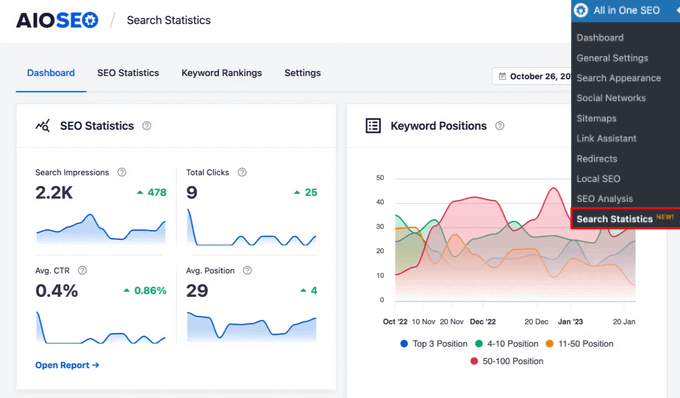
This will bring you to the Search Statistics dashboard. Here, you can view search stats like impressions, total clicks, average click-through rate (CTR), and the average position of all your content for the date range you have set.
You can also see easy-to-read reports on your keyword positions, keyword rankings, content rankings, and more.
You can even view your ‘top winning’ and ‘top losing’ keywords, which are the keywords that have seen the biggest position change in search results.
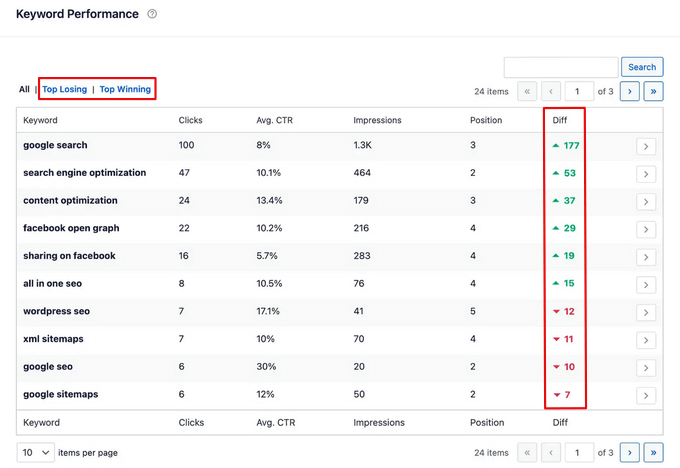
This report, along with AIOSEO’s built-in SEO recommendations, makes it easy to nudge your losing keywords back to the top of search results and ensure your winning content continues to rank well.
In addition, AIOSEO offers a Content Rankings report to help you easily spot content decay. It includes details like the date a URL was last updated, the rate at which your content is decaying, SEO data about each individual URL, and more.
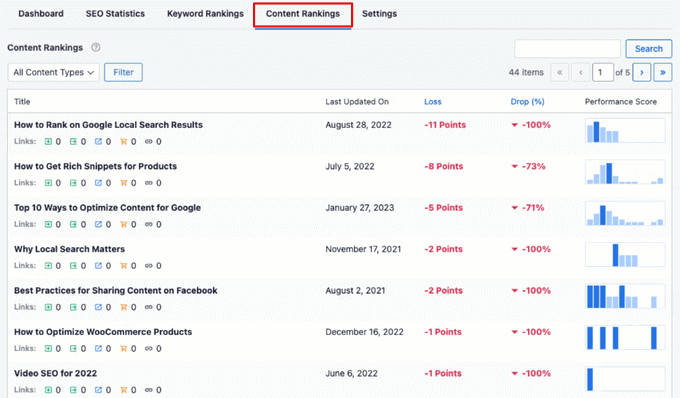
This will help you quickly identify what content needs to be updated and optimized so that you can drive more traffic to your website.
17. Creating Rich Snippets for Your WordPress Pages
Rich snippets or schema markup allows Google to display additional information in its search results. These include star ratings, prices, reviews, and more.
Rich snippets make your page more noticeable in the search results. As a result, you can get more clicks and website traffic.

Many WordPress themes automatically include some basic structured data. If you publish recipes, run a reviews site, or have an online store, then rich snippets can give your site an SEO boost.
Google Search Console makes it very easy to find pages that are displaying rich snippets. It also shows the type of rich snippets for your website.
You can view them by going to ‘Overview’ and then scrolling down to the ‘Enhancements’ section.
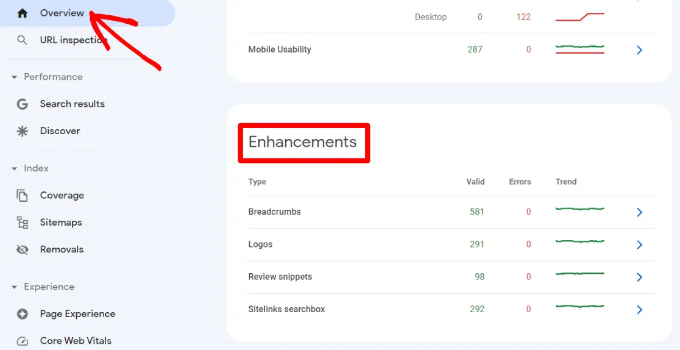
The really useful thing is that the report allows you to quickly look at pages that have errors while displaying rich snippets so that you can fix them.
If you want to learn more about setting up rich snippets, then please see our guide on how to add schema markup in WordPress and WooCommerce.
18. Using Search Console to Improve Mobile Usability
Nearly 63% of all Google searches in the United States come from mobile devices. That’s why Google gives an SEO bump to mobile-friendly websites in the search results.
Google has a Mobile-Friendly test tool called Lighthouse that allows you to quickly examine a page. The Mobile Usability report in Search Console also tells you how Google sees your entire website in mobile performance.
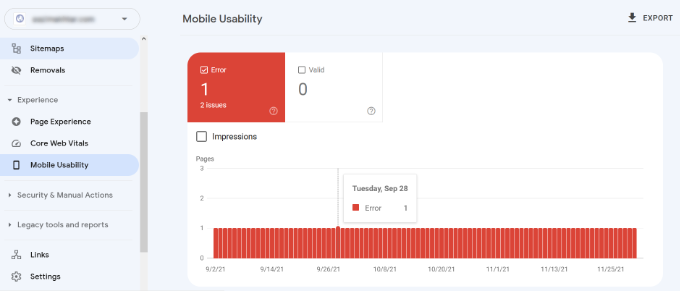
If you see errors on this page, then this means that these issues may affect your site’s rankings.
To see the affected pages, you can scroll down to the ‘Details’ section and click on the error.

Poorly coded WordPress themes or plugins cause most mobile usability issues. The easiest way to fix those issues is by using a responsive WordPress theme.
19. Using the URL Inspection Tool in Search Console
The URL Inspection tool in Google Search Console provides information about a page and whether it’s in the Google search results or not.
You can check the status of a page and also request Google to recrawl a page. To start, simply enter a URL in the top search bar.

Google Search Console will then show you the status of the page that is indexed by Google. If it’s not indexed, then you will see a message saying, ‘URL is not on Google.’
You can click the ‘Requesting Indexing’ button and request Google to manually fetch the page from your website.
Besides that, you can scroll down and see more details in the Pages report. It will show information about sitemaps, crawl history, and indexing.
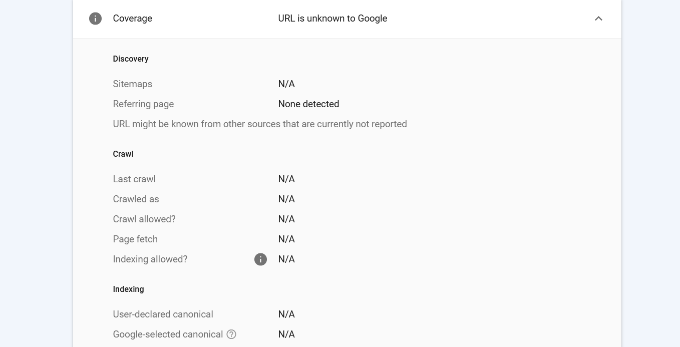
You can also live-test a URL and see if there is an indexable version available.
If there is, then simply click the ‘Request Indexing’ option.
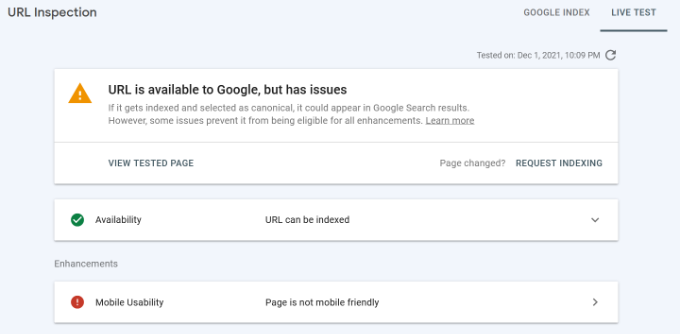
20. Removing URLs From Google Search
So far, we have focused on using Search Console to get your content indexed and improve rankings in Google Search. However, sometimes you may want to remove content from Google Search as well.
One way to do this is to add a noindex meta tag to the page you want to remove from search results. However, depending on how often Google crawls your website, it could take some time before your page actually disappears from search results.
Search Console’s Remove URL tool allows you to request a URL to be removed from the search results. Simply click on ‘Removals’ under Index in the menu on your left.

Now click on the ‘New Request’ button, and a popup window will appear.
Go ahead and enter the URL you want to remove, select whether you want to remove this URL only or with this prefix, and click the ‘Next’ button.
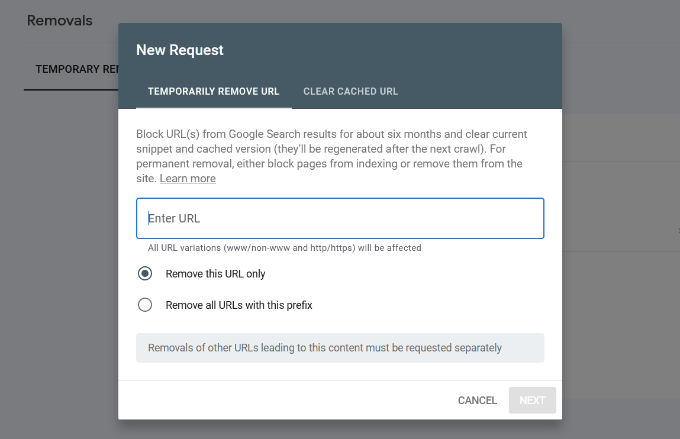
Google will now block the URL from its search results for about 6 months. You can add as many URLs as you want and see them in the Removals section in Search Console.
21. Adding Users to Access Google Search Console
If you have a digital marketing team or you have hired someone to help you with SEO, then those users may also need access to Google Search Console data.
Search Console allows you to easily add users and give them access to view all reports without sharing your Google account credentials with them.
To add a new user, simply click on the Settings » Users and permissions option under Property settings and then click on the ‘Add User’ button.

Next, you need to provide the user’s valid Google account email address.
Then, select a permission to grant them.
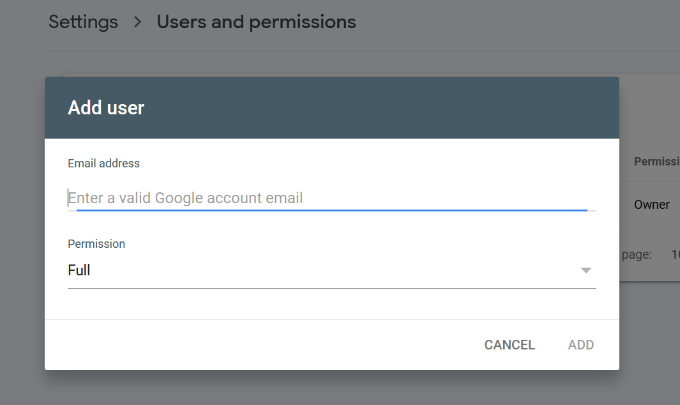
There are two types of permission levels. The full permission level will give them access to everything, including the ability to add new users. Restricted permissions will allow them to view the data but not add new users.
After choosing a permission level, click on the ‘Add’ button to save your changes.
The user who you added will now receive an email notification so they can log in and view Google Search Console data for your website.
Helpful Resources
The following helpful resources on WPBeginner will help you further improve your website’s performance in search engines:
- Ultimate WordPress SEO Guide – Our complete step-by-step WordPress SEO guide will walk you through setting up WordPress SEO like a pro.
- WordPress Performance Guide – Step-by-step guide to improve your WordPress speed and performance for higher search rankings and better user experience.
- WordPress Security Guide – Keep your WordPress site secure with this complete WordPress security guide for beginners.
- Tracking User Engagement – This guide helps you learn how to track user activity on your website and use it to plan your growth strategy.
- Convert Visitors into Customers – If you run an online store, then this guide will show you how to convert search traffic into paying customers.
Expert Guides on Growing WordPress Traffic
Now that you know how to use Google Search Console, you may like to see some other guides related to growing traffic on your WordPress website:
- How to Increase Your Blog Traffic – The Easy Way (Proven Tips)
- WordPress Plugins That Will Quickly Help You Get More Traffic
- How WPBeginner Uses Push Notifications to Grow Return Traffic
- How to Double Your SEO Traffic in 6 Months (With Case Studies)
- How Much Traffic Can WordPress Handle? (+ Expert Scaling Tips)
- How to Check Website Traffic for Any Site (Best Tools)
We hope this article gave you some good tips on using Google Search Console more effectively to grow your site. You may also want to see our guide on how to do an SEO content gap analysis and our expert picks for the best keyword research tools for SEO.
If you liked this article, then please subscribe to our YouTube Channel for WordPress video tutorials. You can also find us on Twitter and Facebook.





Olaf
Google Search Console is a great tool that not only helps you improve SEO and enhance search rankings but also often helps you understand where the problems lie and what Google doesn’t like. It’s basically essential if you want to start optimizing specifically for Google. This tutorial is excellent because it explains some lesser-known issues and how to resolve them. Honestly, Google’s help documentation is terrible, and before I learned to work with the console, I must say my frustration with the help resources was significant. In the end, I sought answers in articles like yours. Google should take a page from your book on how to write helpful documentation and tutorials.
Dayo Olobayo
I’m relieved to learn that Google Search Console is free to use. I thought tools like this would be expensive but now I know I can improve my website’s performance without breaking the bank. Thanks for taking the time to put this together.
WPBeginner Support
You’re welcome, glad we could clarify that it is a free tool
Admin
Moinuddin Waheed
for a newly website, I tried adding website to google search console using AIOSEO and waited a while before validating. But it didn’t validated, showing it does exist.
I tried it several times but didn’t work.
Then I finally made it using file manager, uploading the html file to main public folder and validated.
I don’t know if what time does it take for validation by Google search console through AIOSEO and adding code snippets to wpcode snippets?
WPBeginner Support
It should be the same amount of time as if you manually added the file. The most common reason for a delay like that would normally be a hiccup with the caching needing to be cleared on your site.
Admin
Moinuddin Waheed
Thanks for this much detailed guide on tips and hacks about Google search console.
Hardly what we do in google search console is to add a website and connect it to the Google analytics and never bother to get more out of this useful tool.
like targetting low hanging keywords which can be used to target and easily rank.
I have a query regarding indexing and crawling.
whether they are same or they are different?
also how are they different in terms of what they do?
WPBeginner Support
A crawled page would mean that Google knows the page exists while indexing would mean that it has analyzed the content of the page for it to appear in search results.
Admin
WPBeginner Support
If you deleted the post on the site itself then once Google attempts to recrawl the link after your removal request it will not add the post back into the search results.
Admin
Mrteesurez
Also, while removing a URL from Google search. It shows ‘Temporary Removal’. Does this mean the URL is only remove temporarily because I still found some pages and sites o have removed from Google search even after 6 months.
WPBeginner Support
Correct, the method you have used would remove the link from Google for 6 months which is why it is a temporary removal. You would need to take other steps to permanently remove the page.
Admin
Mrteesurez
Can you tell me the other steps I need to take to remove this URL permanently ??
Even some sub domain I have deleted and not in use again still show contents on search engines.
Iriogbe peter
When you use Google’s “Temporary Removal” tool, it’s a short-term fix to quickly take a page off search results. Yet, it’s temporary, and Google might re-show it over time. For a lasting solution, use methods like a ‘noindex’ tag or update the robots.txt file. Google’s guidelines should guide you for permanent content removal.
Mrteesurez
Ok, thanks.
But I can not use no index for website or pages I have even deleted. Do I need to create bit again to apply this or what ??
How do I adjust or update the robots.txt for website I have deleted and removed its domain.
WPBeginner Support
If you delete a page after removing it from search console then you do not need to worry about noindexing it as when Google recrawls your content it would not see that page to add it to search results.
Peter Iriogbe
According to the Admin, If you’ve deleted a website and its domain, adjusting or updating the robots.txt file is unnecessary. The robots.txt file is specific to a live website and won’t have any impact on a deleted site. Once a website is removed, search engines will naturally cease crawling it. There’s no need to recreate it or apply changes to the robots.txt file for a deleted and non-existent website.
Mrteesurez
Wow, you have really done a great job here. I believe learning never ends. I am just discovering these tips and guides to make best use of Google Search Console.
Thanks for this in-depth, Kudos to WPbeginner.
But my question is: There are some errors I am currently encountering in my blog.
It says: ‘Crawled but not indexed’.
What does this mean ??
The posts affected are not showing on Google search.
WPBeginner Support
That message means that Google knows about the page but has not put the page in search results at the moment. It would depend on the specific content for the steps to consider for those pages.
Admin
Mrteesurez
Specific contents ??
do you mean: either post or page ??
I didn’t the last line of your message.
I want you to know that, I have almost 30 posts on this particular blog.
In search engine console,
some: crawled but currently not indexed’
while some: discovered but currently not indexed’
WPBeginner Support
Not the content type as in post or page but the content on the page itself. Google can sometimes have this message for content that they feel is low value or should be improved before it includes the content. Next to the not indexed there should be an additional reason normally for why it is not indexed.
Jiří Vaněk
I also have quite a lot of results like this on my site. Personally, it always helped me to look at the given article and rework it a little. Edit text or insert new information, or add schema markup using AIO SEO. I then resubmitted the article for indexing in GSC and took this method many times. In my opinion, Google considers the content of the article low and therefore does not index it, even if it knows about it. Changing the ALT text quite often helped me with images. So try this.
Mrteesurez
Thanks you, Jiri.
I will try to work on the tips you just gave.
But as a news blog that use to have short contents and it’s frequently. Does that mean I will have to re-edit those posts manually to solve the issue ??
Iriogbe peter
No, you don’t have to. It is not how lengthy the content is that makes Google index it. (Though content that thoroughly addresses the needs of users is appreciated by search engines like Google)
I had a similar issue not quite long ago. I fixed it by writing multiple blogs in one type of category instead of just writing any topic. For example, I had a category in marketing so I wrote more than 10 posts about marketing and so on
Sometimes, especially for a new blog website it might take time for some of your content to be indexed. This is because search engines want to understand the type of content you want to serve with your website before they start indexing it. I recommend you have multiple content in the same category to help Google see the need to crawl and index your blog posts. For example, you might write a blog about SEO in many different ways( not just in one post but many) Doing so will trigger your website to Google crawlers that you are expertise in that niche giving your content the chance to be indexed.
Jiří Vaněk
If the articles are short, like some news, it can also be the reason that Google does not consider the content to be relevant. I often expand such articles and explanations. There is a term in the article, so I will provide a highlighted explanation for it (with the help of text from artificial intelligence). it helps to increase the content in a very easy way and it is more relevant.
Ahmed Omar
search console with no doubt is a powerful need for any site. and when ever I made changes to it to improve the performance, I always find new powerful changes
Tip number was good as I noticed it in many searches and I do not know how to do it , no it is all clear number
THANKGOD JONATHAN
I have just posted a comment on this post but I think I still need to make another comment after my experience with tip 12.
In my case I have tried filtering the result to “position” as you metioned in tip 12 above in this post but their is no position option in the filter. I can only see queries, clicks and impressions.
Please why is my own result different?
WPBeginner Support
Please check the icon next to the download button to see if it is unchecked for you to have it not visible.
Admin
THANKGOD JONATHAN
Thank you for the post.
I really got some tips I never know. much especially method 12. Finding Low-Hanging Keywords Where You Can Easily Rank. It the method I never use and I gonna try it out.
Moinuddin Waheed
Though I have done a lot in the Google search console, there is always room for improvement. I can here to check whether I have done everything the right way and found some of the things as to do for my websites.
This is purely a gold mine of tips and tricks for improving Google search console usability.
Thanks a lot wpbeginner.
Jiří Vaněk
Thank you for the great articles. I made it a task to go through your older articles, and even though I already know quite a lot, I always find some piece of the puzzle that had escaped me before. As I go through your older content now, I always stumble upon something that can be improved or implemented into my own website. You’re great.
WPBeginner Support
You’re welcome!
Admin
Ahmed Omar
Thank you so much for this helpful information.
I went through a recheck for most of the mentioned tips and I made sure it is all active on my site.
there was few missing things which Adding an XML Sitemap is one of them and I am working on it now to fix it
WPBeginner Support
You’re welcome, glad our tips were helpful
Admin
Ahmed Omar
important post with unique tips.
I took many notes from here, but number 12 is the one thatci was working on it in the last few months ” Finding Low-hanging Keywords Where You Can Easily Rank ”
Thank you
WPBeginner Support
Happy to hear our guide is helpful and we wish you luck with the keywords
Admin
Emma
Hi! Thanks for a helpful article and all your helpful articles in fact!
I have set up both Google Search console and Google analytics and am verified domain owner.
However, I am unable to connect console to analytics as given in the steps above. When I get to Enable Search Console data in Google Analytics it says I don’t have any verified sites under search console – even though my website is set up and showing data in google search console!
Can you offer any advice or link to an article please?!
WPBeginner Support
You would need to verify your account in Google’s Search Console before you can connect it, we would recommend taking a look at our guide below:
https://www.wpbeginner.com/beginners-guide/how-to-add-your-wordpress-site-to-google-webmaster-tools/
Admin
Christina Henry
i find all your articles brilliant. You’ve helped me so much. Thankyou
WPBeginner Support
Glad you’ve found our content helpful
Admin
Abdul Ahad
Hello,
Thanks for this great guide. I just want to say that step 2 is not applicable anymore and I cannot switch to the older version to reach site settings. Can you please provide a link to reach that page.
Also while doing step one, I was asked to select from domain and url prefix. that was something new which is not explained in this article, can you please elaborate the difference between both.
Thank you
WPBeginner Support
Thank you for letting us know that Google has updated their interface and method, we will look into updating this article as soon as we are able.
Admin
cheryl watson
Thank goodness you exist. finally finding my round wordpress and building my blog! phew…
WPBeginner Support
Glad you’ve found our guides helpful
Admin
Info
Really helpful articles you are supplying, I am learning an incredible amount of information here!!!
WPBeginner Support
Glad you found our guides helpful
Admin
Vegancheapneasy
Hello guys, thanks for the awesome article. I am a beginner stiil and I added all website versions to my search console properties (http, https, www etc). I want to ask you – when I connect analytics to the search console, should I repeat the process to add every version of my site or just the primary one that is in the wordpress general settings?
WPBeginner Support
Only worry about the primary address in your settings
Admin
Becky Antkowiak
Hey, there,
Just an FYI, you can no longer set preferred domain. Google has apparently removed this option.
Thanks for all your hard work. I started with one article and then I’ve been down the rabbit hole for the last several hours following links to “oh, wow, I need to know that, too!”
Have a super day!
WPBeginner Support
Thanks for letting us know, we’ll be sure to look into updating the article
Admin
Louise Findlay
Hi. Can you still access the old search console? Also, I have verified sites in Google Search Console but they don’t show up when I try to connect them to Google Analytics.
WPBeginner Support
If Google has updated the interface then sadly, not at the moment. For connecting your site to Google Analytics you may want to take a look at our guide here: https://www.wpbeginner.com/beginners-guide/how-to-install-google-analytics-in-wordpress/
Admin
hannachi
Great Article Thank you so much for all this information.
WPBeginner Support
Thank you and you’re welcome
Admin
Jonathan
Great post thank you!
Before I begin you should know that I have been following the steps you have laid out and have verified my site successfully, but…I have 2 issues I wonder if you could help me with.
Firstly, when I go to the old version of search console to set my preferred domain, a popup comes up basically saying that I have to “verify my site”. (which has been done already)
The second thing is when I try to save to the https: version on google analytics, I can save the https on the “view settings” but it won’t save under the “property settings”.
Any help you can give me in these issues would be greatly appreciated!
Thank you!
WPBeginner Support
Hi Jonathan,
Did you verify your site as HTTP or HTTPs. The URL you submit as the preferred domain name should be the same as your search console
Admin
Athar Bhatt
Great Article Like every other article on wpbeginner.com
Thank you so much
Koushik
Thank you so much for this helpful information.Recently I started my new website.This is really helpful to grow up.Thanks,Syed.
WPBeginner Support
Hi Koushik,
We re really glad that you found this guide helpful.
Admin
Fodiyo
Thank you so much for your wonderful support and information
WPBeginner Support
Hey Fodiyo,
You are welcome
Admin
Laurinda
Amazing content! Thank you so much. As a beginner website owner, I find this information really helpful. This is definitely an article to keep in a safe place for future reference. Thanks.
WPBeginner Support
Hi Laurinda,
We are glad you found it helpful.
Admin
Anwar
Guyz, this information is so useful
Ellen
Hello Syed,T
Thank you so much for all this information.
For someone like myself, who knows nothing, this is exactly what I need right now.
I will need to study this and start making progress.
With best wishes,
Ellen
Editorial Staff
Thanks Ellen
Admin